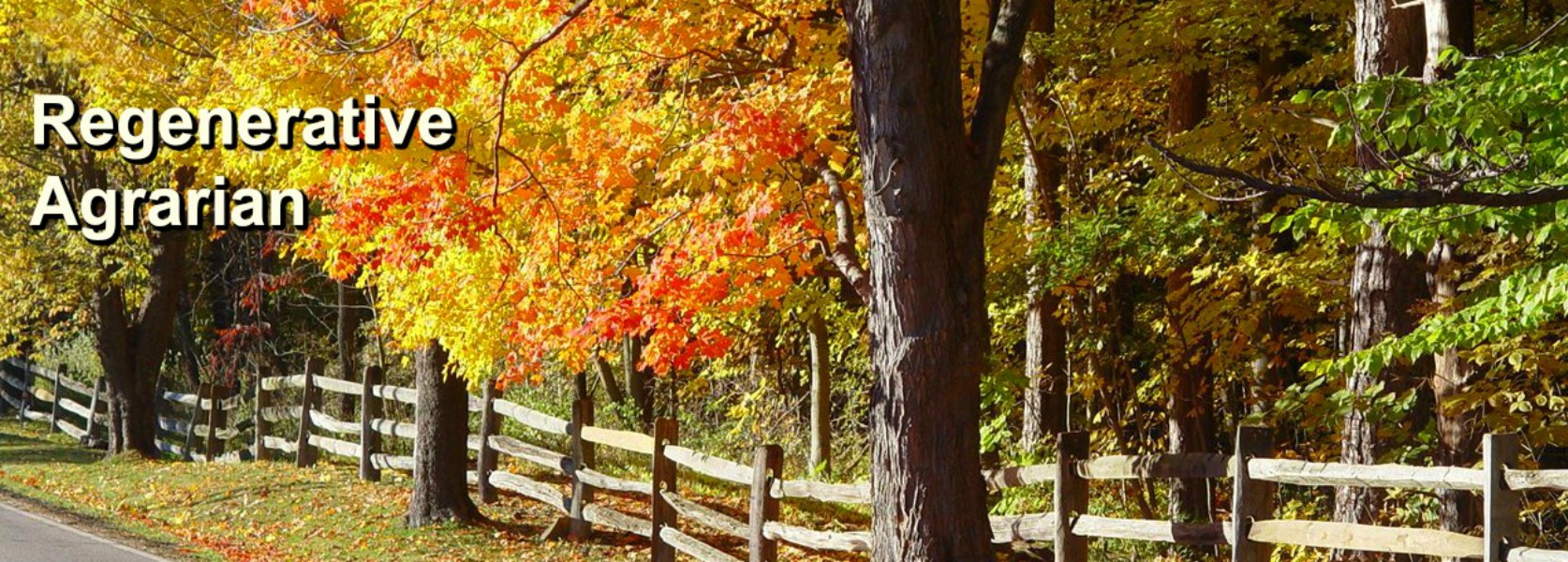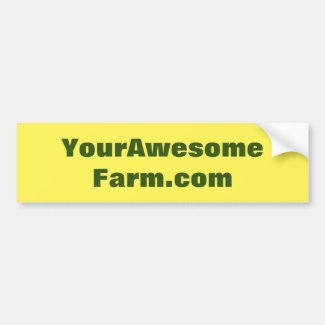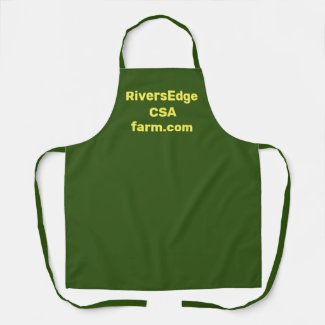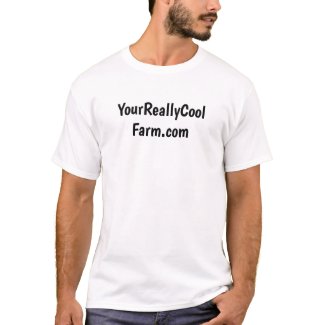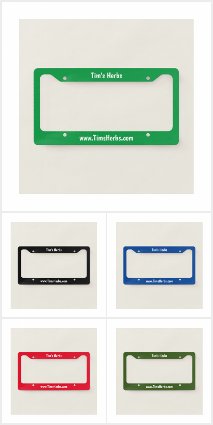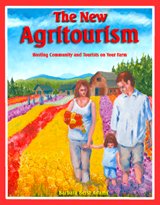Washington State road trip from east to west, north to south:
· Farm marketing strategies,
· eco-farming methods,
· on-farm kitchen for value-added farm products,
· on-farm restaurant
· and more...
Washington State is divided by the Cascade Mountains. This creates two very different climates in the state. The west side receives maritime rainfall and cooler summers. This side even has a temperate rainforest. On the east side where the mountains have cut off the maritime precipitation, there are deserts and drier, more open pine forests. So here we go on a road trip to see some of the many successful eco-farms across the state.
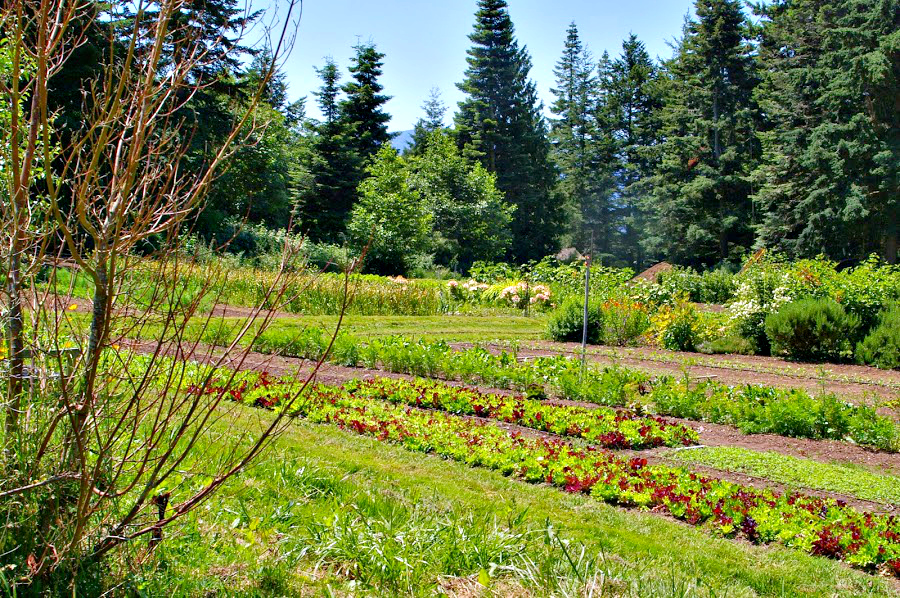
WESTERN WASHINGTON, LUMMI ISLAND: Starting with Nettles Farm on remote Lummi Island in the Northwest part of the state, with only a small ferryboat access. The farm was filled with market gardens, greenhouses, and surrounding wildlands where they also wildcrafted. At the time, their customers were local high end restaurants and their local farmers' market.
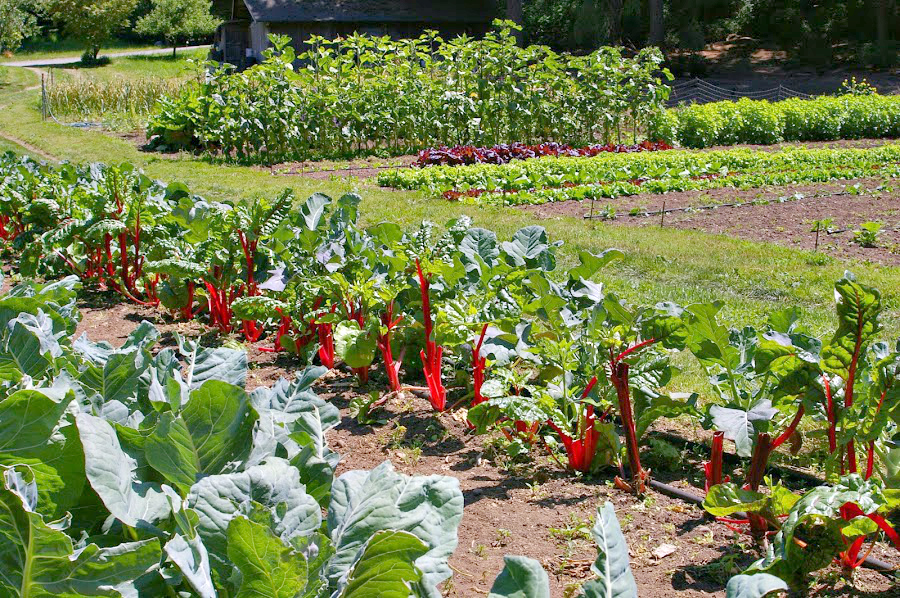
WESTERN WASHINGTON, LUMMI ISLAND: I included information, photos and quotes from Nettles Farm in articles for Hobby Farms magazine and AcresUSA on the eco-farm chef connection (a version of one of those articles here) because they worked directly with chefs when choosing which crops to grow season to season. Since the crops were garden to chef, no concern had to be taken as far as shipability over long distances. Therefore, tender, delicate varieties, including heirlooms, could be grown for a guaranteed market. Besides flavor and aroma, texture and color were very important for the chefs' presentations.
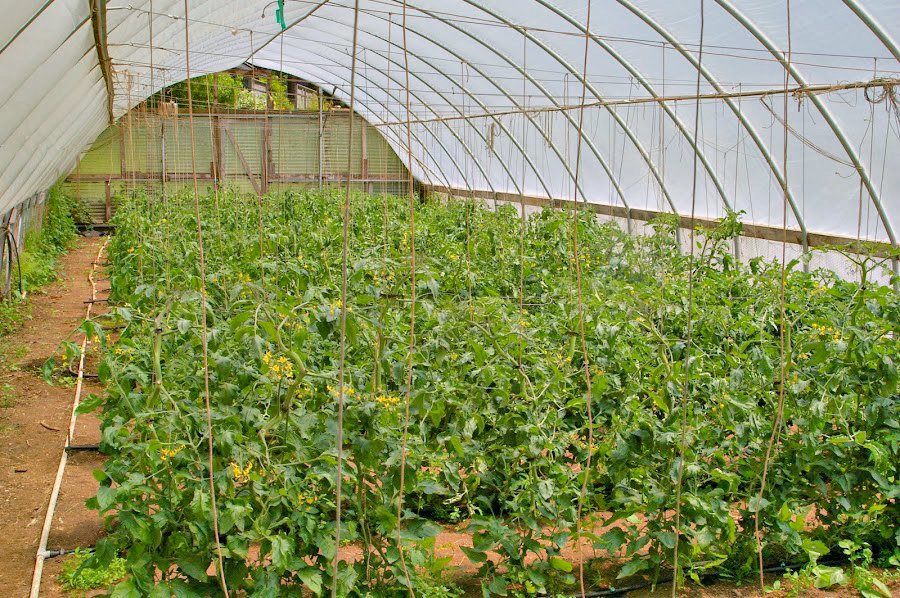
WESTERN WASHINGTON, LUMMI ISLAND: Lummi Island summers are cool, so the farm's tomatoes are seen here grown in a greenhouse. The tomatoes grow right in the ground vs. in pots. Once, a disease took hold of the tomatoes, and below is how Nettles Farm solved it...
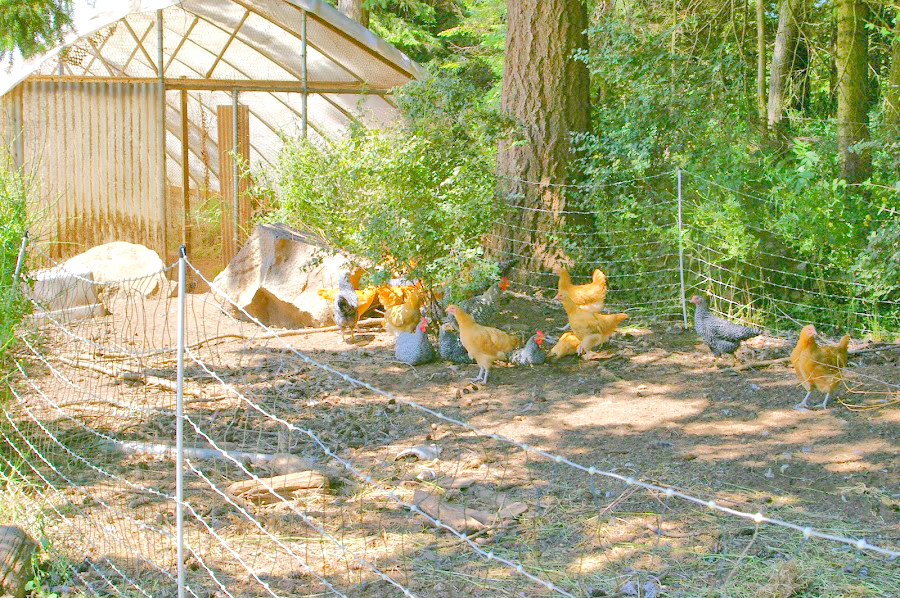
WESTERN WASHINGTON, LUMMI ISLAND: ...they let some of their chickens live in the greenhouse over part of a winter. They removed them in time for the manure to compost, and the disease was irradicated completely.
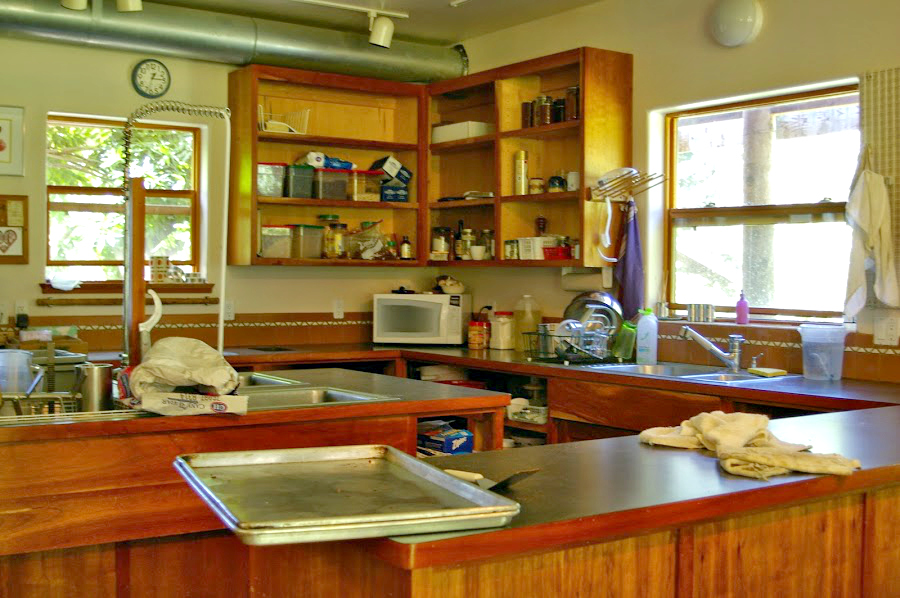
WESTERN WASHINGTON, LUMMI ISLAND: We got to see Nettles Farm's own certified on-farm kitchen where they produced a variety of value-added food products from their crops and wildcrafting.
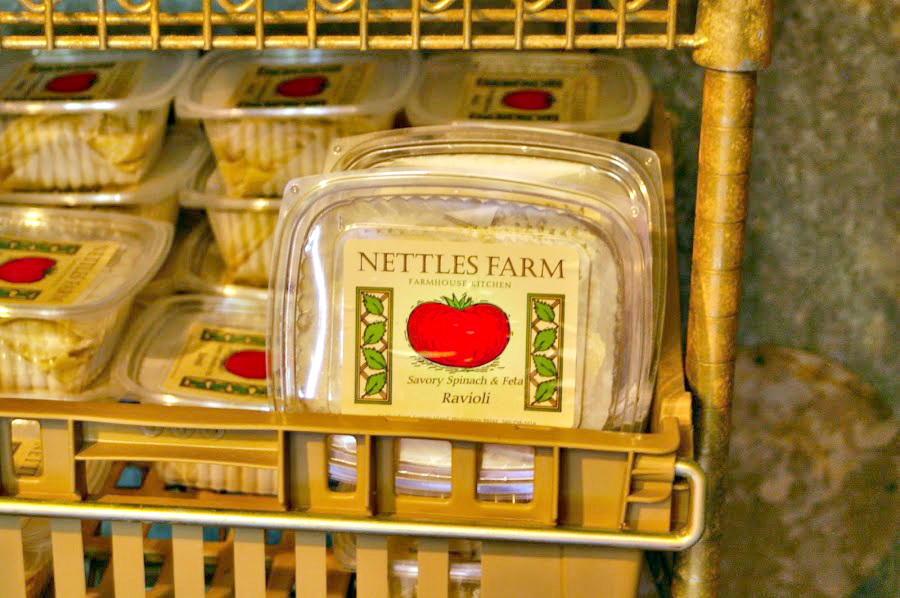
WESTERN WASHINGTON, LUMMI ISLAND: The ingredients of their food products, such as their raviolli, changed as the seasons changed, depending on what was ripe and available at the time of the making.
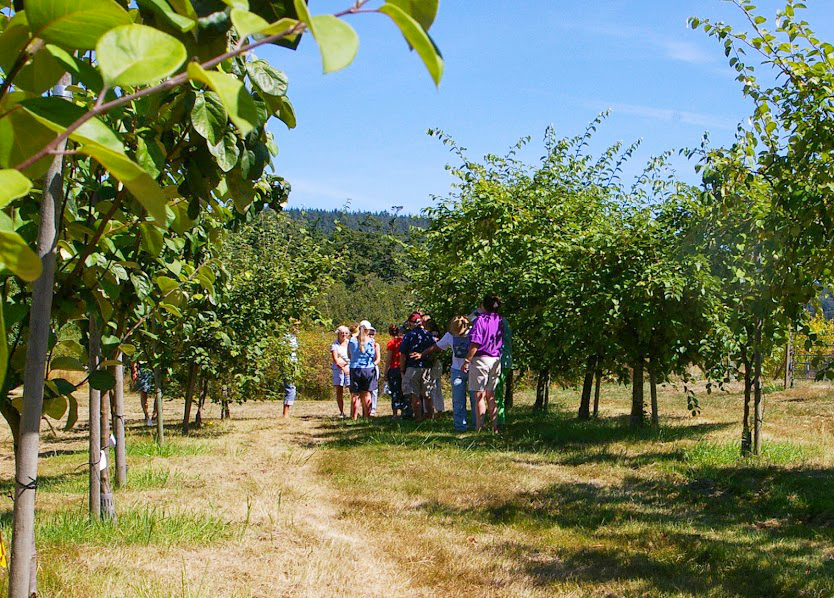
WESTERN WASHINGTON, GUEMES ISLAND: A little further south, but still solidly in the northwest region of the state, Guemes Island is also accessed only by ferryboat and is across from Fidalgo Island -- the drive-on island with the town of Anacortes and the ferry terminal that takes people to the San Juan Islands. On Guemes, we toured this quince farm called Willowrose Bay.
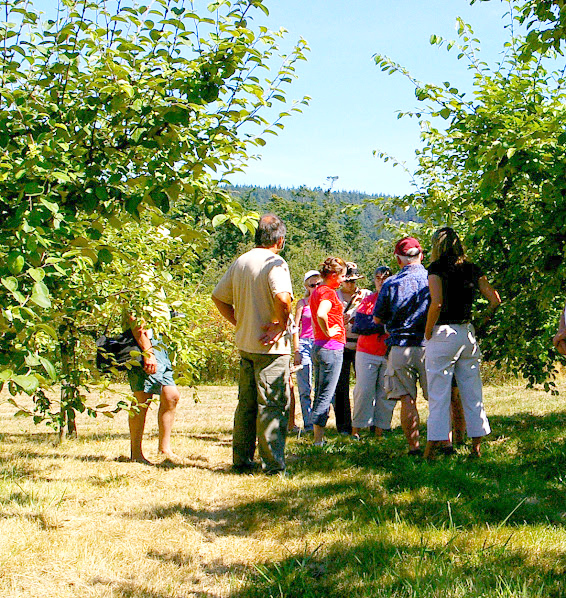
WESTERN WASHINGTON, GUEMES ISLAND: Growing a niche crop like quince, Willowrose Bay sold the crop in a variety of ways including fresh and made into preserves, so therefore diversifying their crops vertically. And one great and essentially free marketing strategy was to become involved in the local Slow Food Movement that arranged field trips to the orchard. We foodies never forgot that tour, and when we saw their products at farmers' markets and food co-ops, we became loyal customers.
Of course, "free" is never free... the orchard owners had to spend time planning, leading, and cleaning up after the tour. But for farmers and ranchers who sell products direct to customers, it can be very helpful for their farm's name/brand.
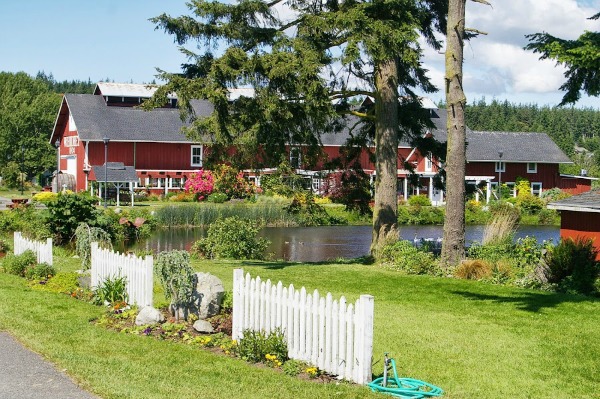
WESTERN WASHINGTON, WHIDBEY ISLAND: This island is just south of Guemes Island. Greenbank Farm in the southern half of Whidbey stands out as an example of what a community can do together to secure eco-friendly farming and farmland in their own areas.
This historic former loganberry farm was about to succumb to residential development. But the local citizens rallied to save it, and turned it into a mecca for nature lovers, sustainable farmers and gardeners instead. I had this photo above published with an article I wrote on the farm for Heirloom Gardener Magazine back when the great late Karen Will was the editor.
The red buildings you see house a variety of projects including a cozy little cafe that makes some of the best berry pies in the world, and overlooks the duck pond.
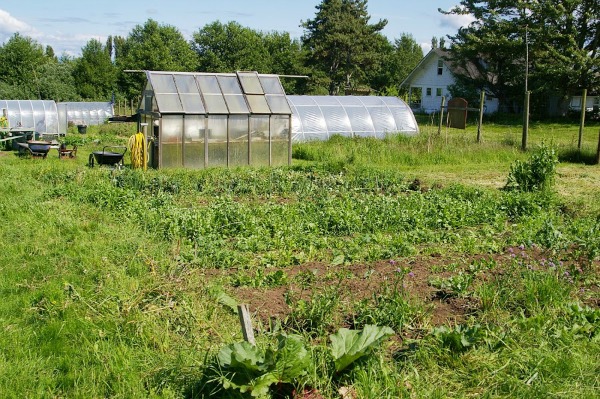
WESTERN WASHINGTON, WHIDBEY ISLAND: Organic farming workshops and open-pollinated seed research takes place on Greenbank Farm. And it also hosts p-patches for the local community.
Since since this writing, Greenbank Farm has changed hands with different entities operating it, so changes are no doubt underway.
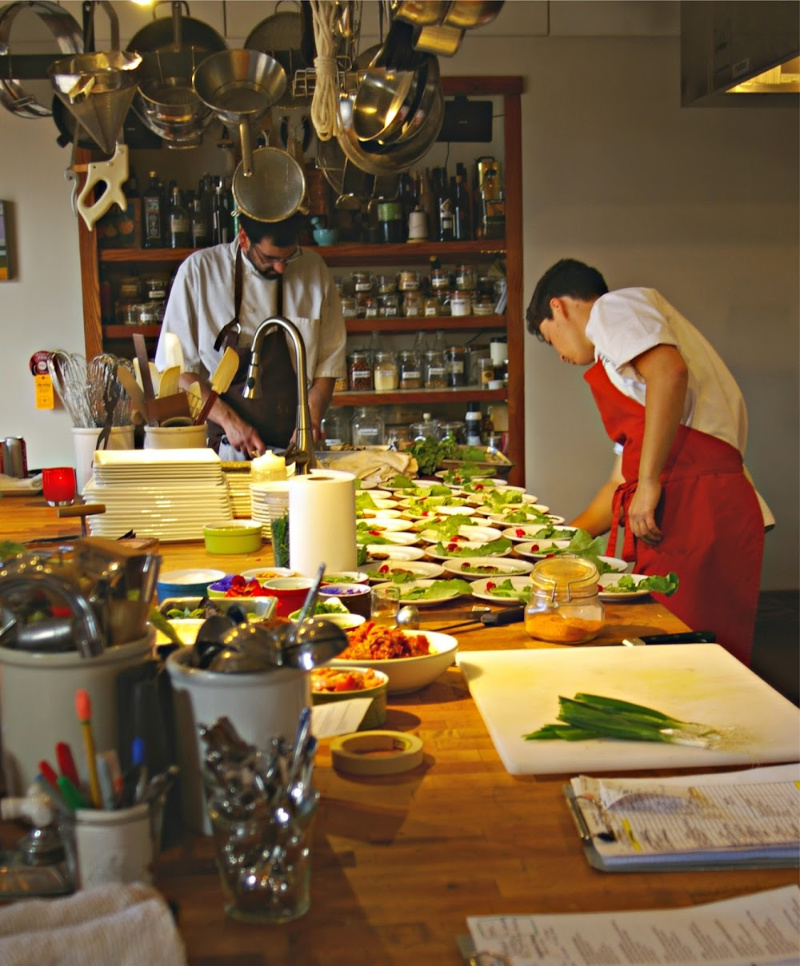
WESTERN WASHINGTON, WHIDBEY ISLAND: Yet another gem on Whidbey Island is Orchard Kitchen, a farm-to-table destination owned by Vincent and Tyla Nattress. The small restaurant's prep kitchen you see above is in their renovated barn within the acres of their organic farm. Dinner offerings change with what's ready for harvest from their organic acres.
Along with their own unique produce, they collaborate with other local farmers, vinters, cheesemakers, chefs and oyster harvesters.
They also offer cooking classes and a seasonal daily self-checkout farm stand.
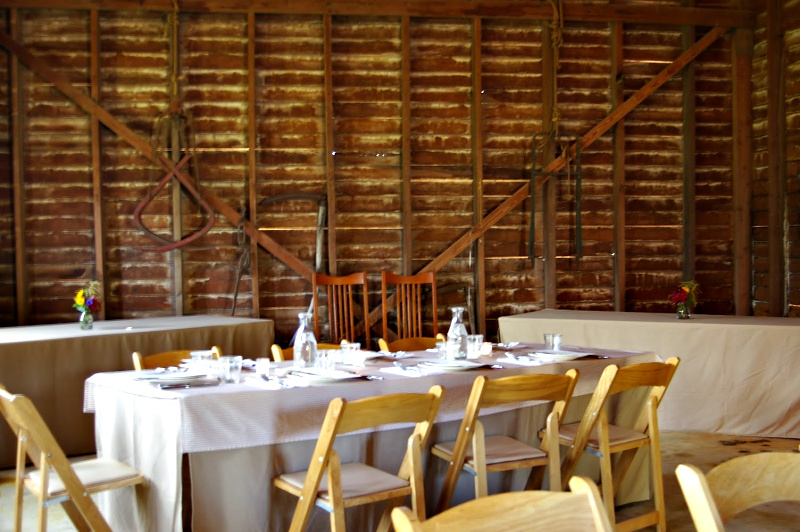
WESTERN WASHINGTON, WHIDBEY ISLAND: Orchard Kitchen also has another barn steps away that they renovated as spill-over for when the small main restaurant is too full, or for cases like ours where seven of us came together and got to have the whole barn to ourselves.
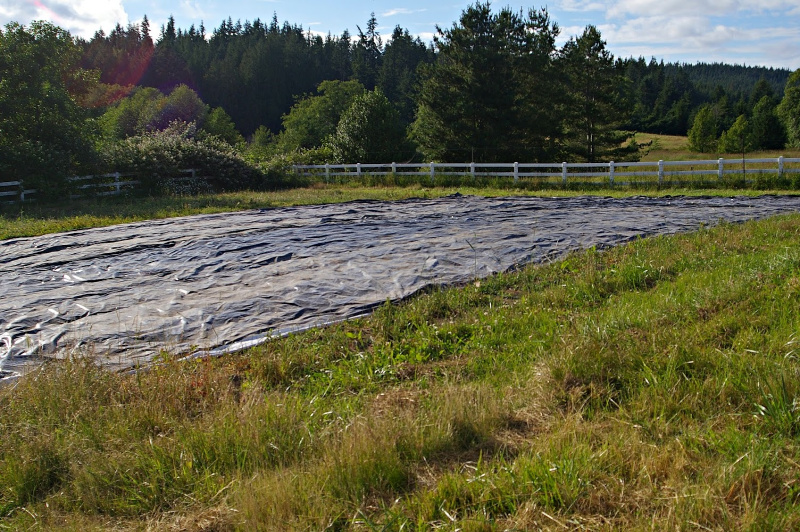
WESTERN WASHINGTON, WHIDBEY ISLAND: Here's one way at Kitchen Orchard to prepare ground for planting without tilling, which we try to avoid in regenerative ag. Options to plastic include paper topped with organic mulch.
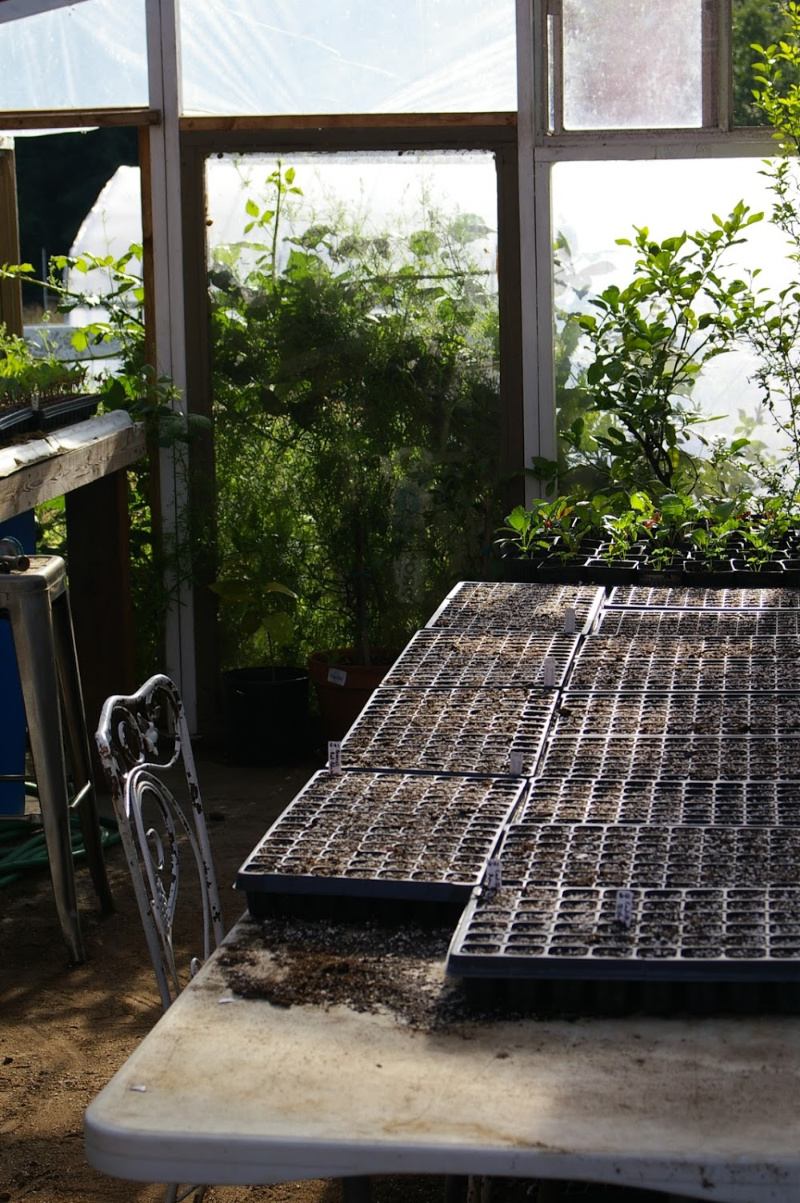
WESTERN WASHINGTON, WHIDBEY ISLAND: How would you like to have this for your office? A chair pulled up to a table for planting crop starts inside a greenhouse potting shed at Kitchen Orcahrd. As a child, I loved the feeling inside my grandmother's greenhouse that my grandpa built from old windows. I'd choose this "office" any day.
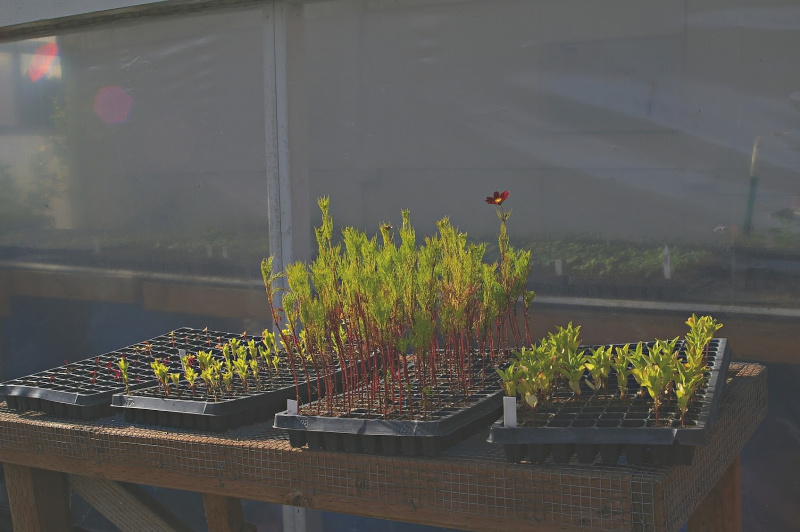
WESTERN WASHINGTON, WHIDBEY ISLAND: A shot through the gauzy greenhouse film at Kitchen Orchard.
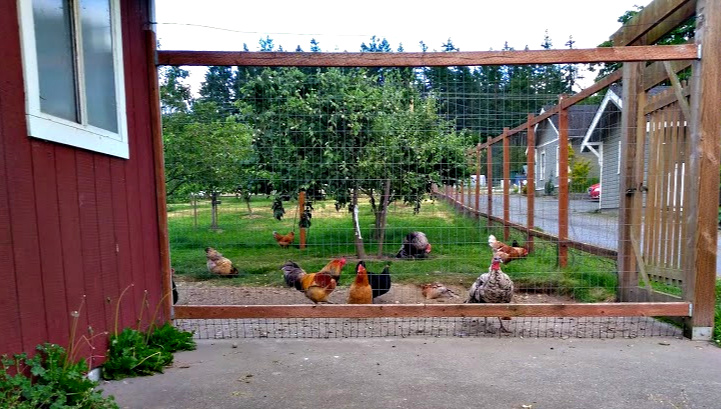
WESTERN WASHINGTON, WHIDBEY ISLAND, Chickens and turkeys patrol the orchard at Orchard Kitchen. Poultry can make excellent companions to orchards: eating fallen fruit where disease can be borne, aerating the soil with their scratching, eating the orchard insect pests during their ground-dwelling stages.
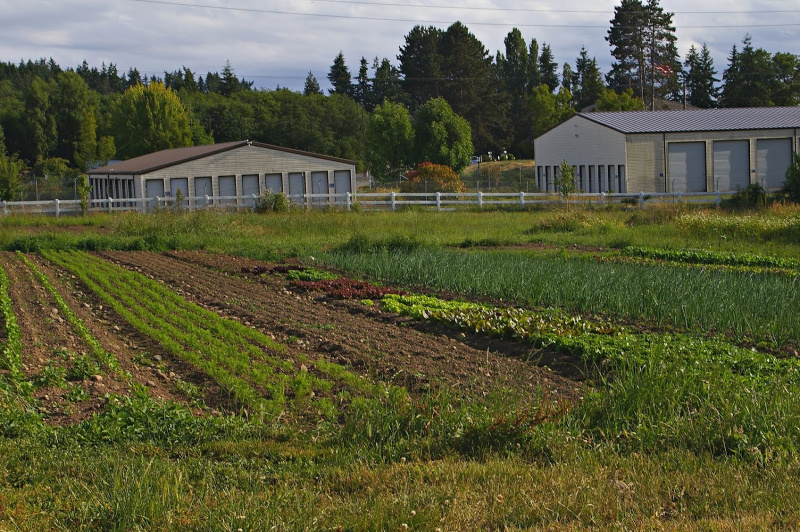
WESTERN WASHINGTON, WHIDBEY ISLAND: Guests can see these wide row planting beds from an outdoor deck off Orchard Kitchen's main eating area.
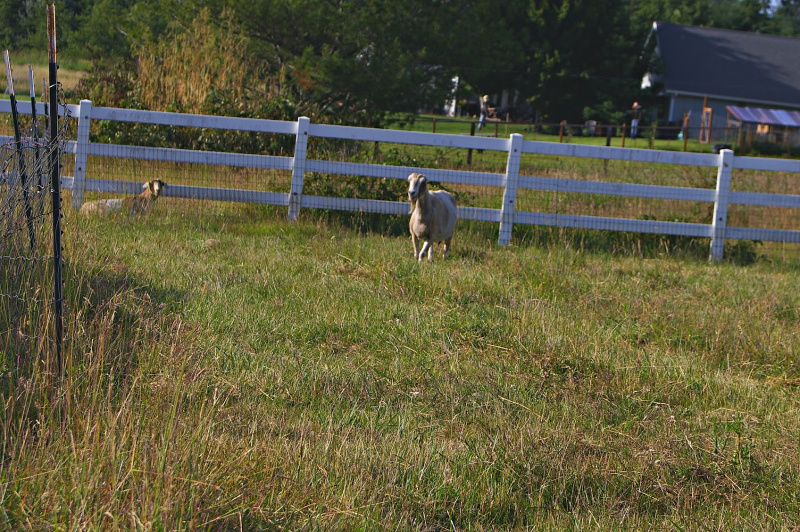
WESTERN WASHINGTON, WHIDBEY ISLAND: Two goats reside at Orchard Kitchen, with their job being to help keep grassland areas clear, and to contribute to compost material for the farm.
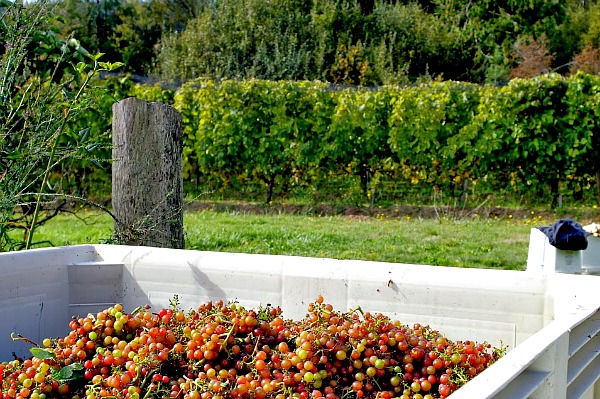
WESTERN WASHINGTON, LOPEZ ISLAND: Heading further west into the Salish Sea in Puget Sound, Lopez Island is one of the main San Juan Islands accessible by major ferryboats. We spent the day at Lopez Island Vineyards, the oldest vineyard in the San Juans. They utilize organic grape growing methods but also had a very clever agritourism marketing plan explained more below:
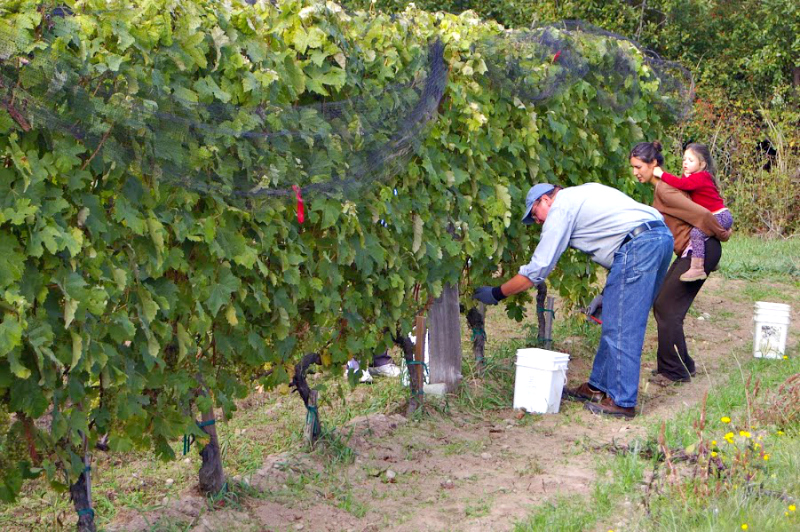
WESTERN WASHINGTON, LOPEZ ISLAND: Each harvest season, interested people on their emailing list start getting notifications on which weekend the grapes will be ready for a harvest festival. We were able to taste wines and nibble on delicious foods, learn how to properly harvest the grapes from the vines, and learn other wine making and grape growing knowledge strait from the source of these people who have grown grapes here for more than 30 years. Couples even came with their children. After that day, their bottles of wine certainly stood out among other wines on the store shelves for those who attended their gathering.
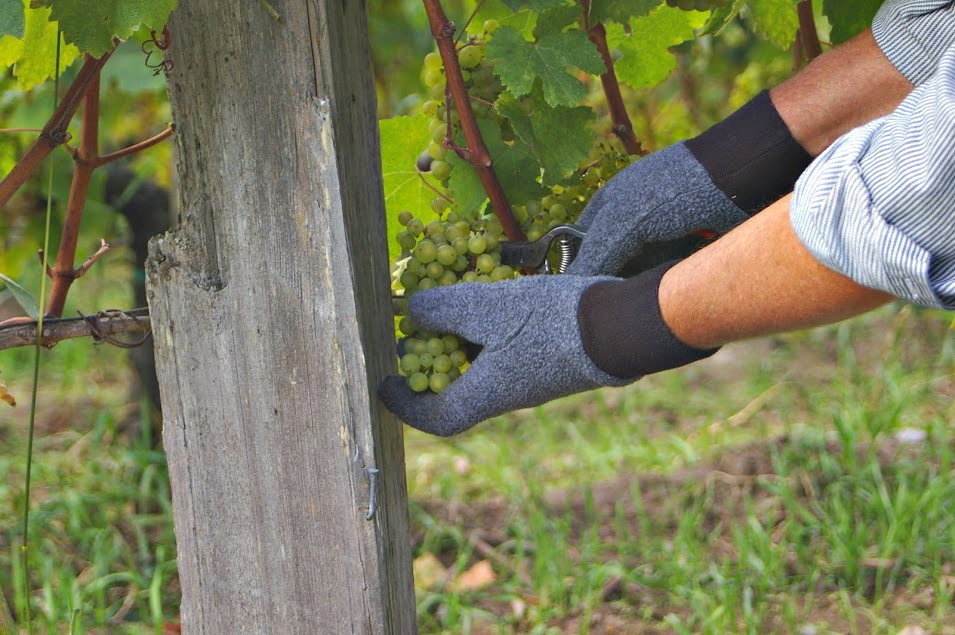
WESTERN WASHINGTON, LOPEZ ISLAND: Guests helped with the actual harvest, and showed each of us specifically how to hold the clusters while cutting them off.
The owners now also host performers in their vineyard, and often have their tasting rooms open on weekends. When non-farmers step foot onto the beautiful land that nurtures the vines, see the wildlife it supports, and experience some of what it takes to produce a bottle of wine, their support and respect for farmers grows. Agritourism can be a valuable tool to restore well-paid and respected farmers into our society in which they almost disappeared in place of corporate off-farm wealthy "farmers" and farm laborers who could barely earn a living.
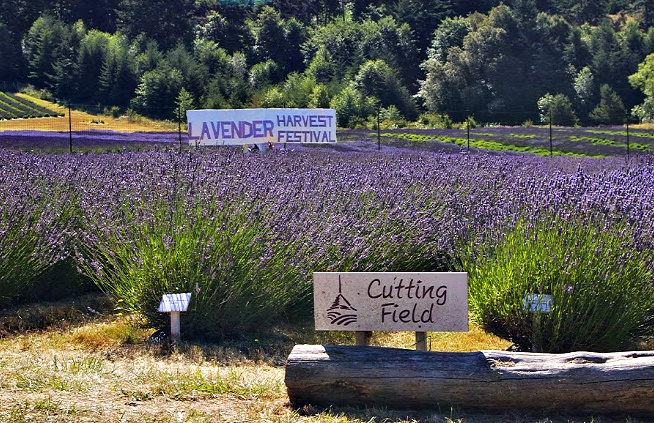
WESTERN WASHINGTON, SAN JUAN ISLAND: Speaking of agritourism, here's a lavender farm that profits well from the goodwill and sales that result from their harvest festival. The San Juan Islands are made up of multiple islands, and one of them is actually named San Juan Island. It's the furthest west of the US islands served by major ferryboats. And on it is Pelindaba Lavender Farm -- 25 acres with lake and mountain views. You could almost feel the buzzing of the honeybees and see swallowtails and other wildlife flourishing on this organic farm.
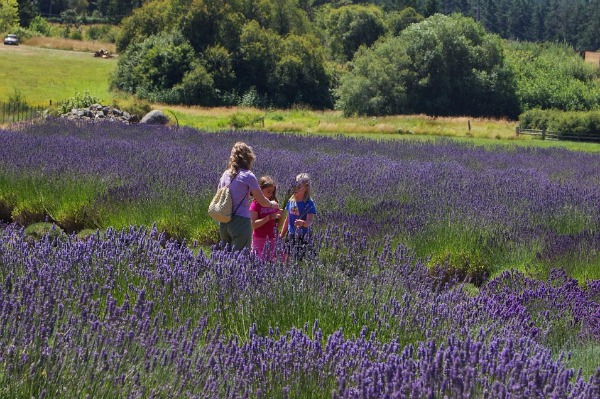
WESTERN WASHINGTON, SAN JUAN ISLAND: What could be more beautiful than this mother with her daughter and daughter's friend picking bouquets out in the midst of a lavender field.
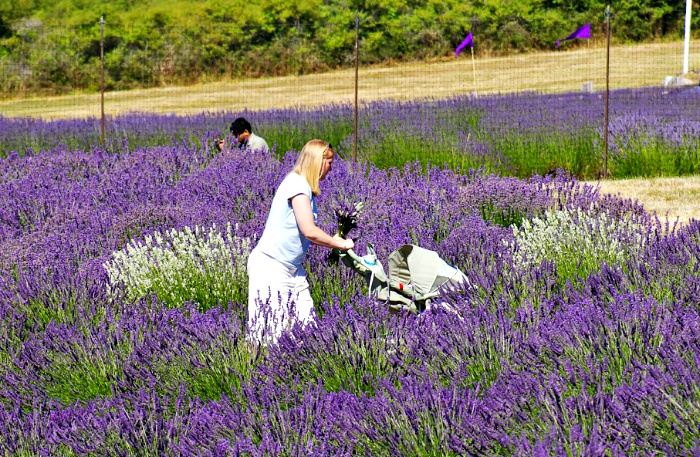
WESTERN WASHINGTON, SAN JUAN ISLAND: And another mother enjoys the flowering fields with her child.
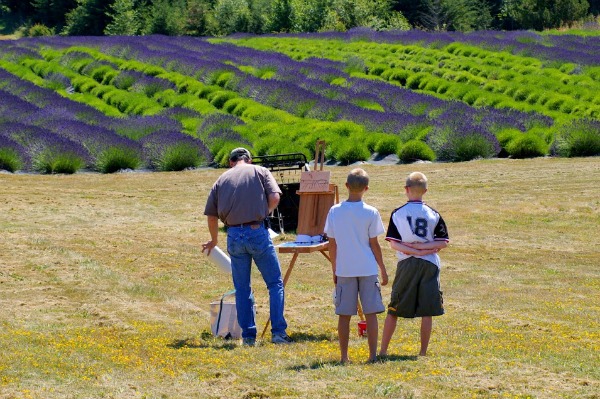
WESTERN WASHINGTON, SAN JUAN ISLAND: Some of the more unusual agritourism activities included allowing artists to come paint their fields during days that were open to the public. It was heartening to see these two boys venture close to witness art in the making.
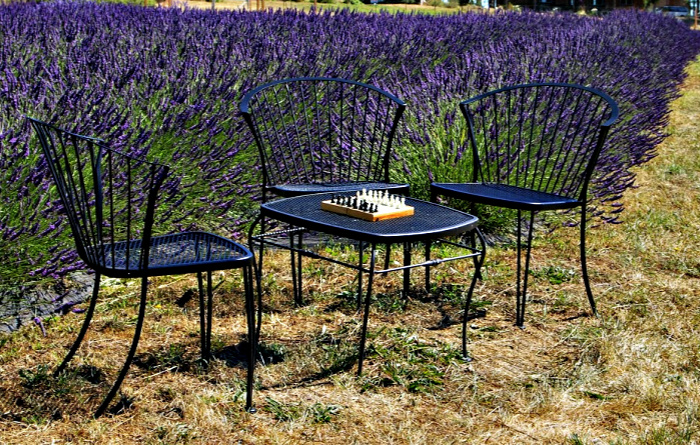
WESTERN WASHINGTON, SAN JUAN ISLAND: They also set up places to rest or play chess among the fields, and offered lavender related workshops for both kids and adults (such as how to make lavender wands). They took people through their areas where they did their distillation and put together other value-added products they offered for sale.
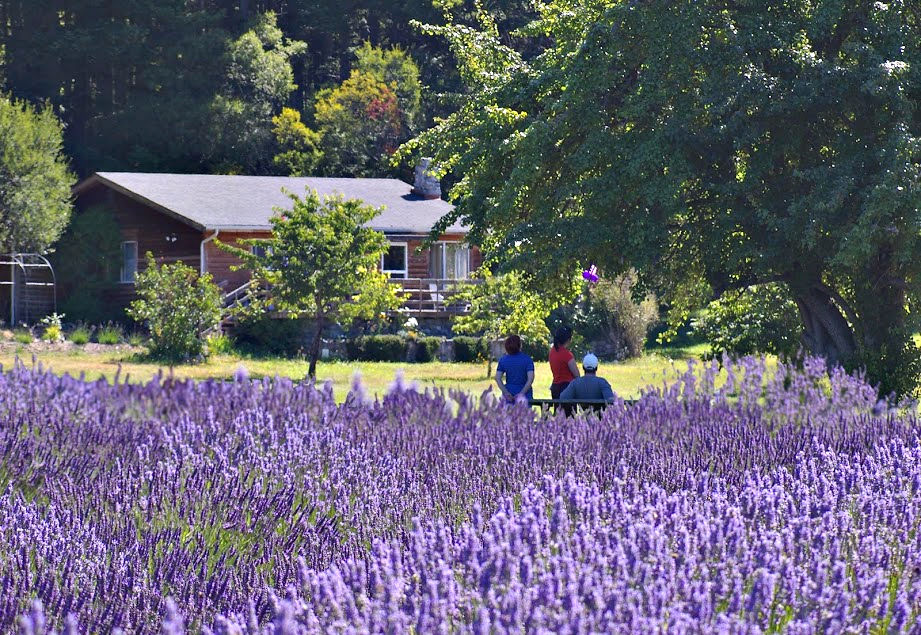
WESTERN WASHINGTON, SAN JUAN ISLAND: At the time, a day spa called Lavendara Day Spa was also operating on the farm in a lovely, rustic smaller building at the edge of the lavender fields which you can see in the photo above.
The day spa used many of the farm's products for its massage, face treatments, foot soaks and other service offerings. This was the main reason we went to the farm: for me to gather information and photos to write up an article on Lavendara for Day Spa Magazine. That article has been put up here to show how other farms that produce spa-worthy products such as essential oils or herbal bath care products can learn from their success. However, Lavendara eventually had to relocate to the small town area on San Juan Island (where it continues to succeed) because of an ordinance against allowing that kind of business in rural areas. This isn't the case for every rural location, but it does go to show that before certain agritourism events are held on our farms, we need to look into the legal and liability issues first.
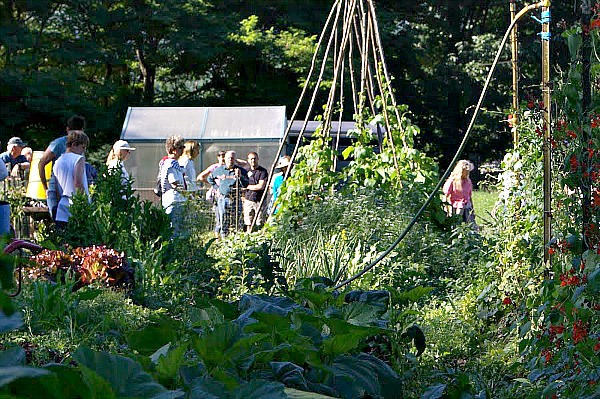
WESTERN WASHINGTON, SKAGIT VALLEY: Heading east off the islands onto Washington's mainland, in the fertile Skagit Valley one can see farm crops and animals of all types -- from the famous Skagit Valley tulips that rival Holland's fields, to dairy cows, blueberries, hops, field crops. More are transitioning to organic and eco-friendly. We visited Skagit River Ranch, which raises 100% pastured chickens, pigs and cattle using deep ecological methods beyond organic. Their field day was so informative and highly recommended if you ever get the chance to attend one. The information can't be found in books and includes insights on the energetic properties and benefits of humic acid and fulvic acid and how he applies them on his farm.
They also produced their own food garden from soils made rich with their animal manures. This photo shows how tall their bean trellises are, though it doesn't show their "chunnel," which they had long before they were called chunnels. Their chicken tunnel surrounded the garden where chickens scampered about, halting any migrating slugs or snails headed into the garden, and happily eating and shredding garden scraps tossed into their area, like stems and leaves.
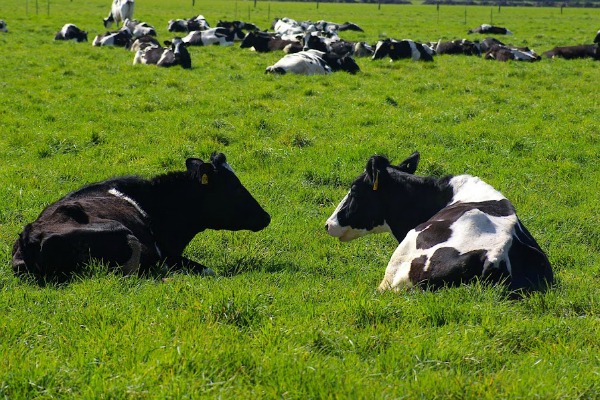
WESTERN WASHINGTON, SKAGIT VALLEY: I love seeing cattle out on green pastures. These were in another's field somewhat close to Skagit River Ranch.
Some dairy and beef farms in Washington are implementing Savory's methods. Other regenerative methods I hope expand in this area include the use of heritage cattle breeds such as the Swiss Brown, which is dual purpose, and makes it easier for dairy farmers to remove themselves from the veal industry, which takes the calves from the mothers to slaughter them as babies for veal. By using Brown Swiss -- being both beef and dairy productive -- one dairyman in another state allows calves to stay out on pasture with their herd, and grow into adulthood for grassfed beef for a dual beef, dairy income.
Some of the heritage beef and dairy breeds are also especially good at thriving on live pasture flora, whereas some modern breeds depend more on grain and other concentrates to produce.
The heritage breeds also more often maintain instincts on how to protect themselves and their own calves from larger predators. When these instincts are lacking, the cattle are vulnerable to wolf and bear attacks, and ranchers in the past had to shoot them to protect their herds. The non-protective cattle simply spread out on the range, making themselves more vulnerable, and sometimes nearly ignore their own calves. By contrast, breeds that still maintain protective instincts will remain gathered together and stand in a formation with the stronger horned members on the outside protecting the younger and more vulnerable members on the inside of their circle. Some ranchers have found they can allow the larger predators to remain unharmed and part of their ranches' natural eco-structure when their cattle's natural protective instincts are restored (along with other methods such as having cowboys and cowgirls out on the range with the herds.)
Another promising dairy project includes the Audubon Society's pasture certification program, which helps farmers maintain birds and other wildlife on their pastures, and doesn't allow cruel harvesting methods as beef cattle in this program cannot be removed to the CAFO system for finishing.
(People loved our photo above, so it was made into a friendship greeting card, "It's quite extraordinary... ...that when we hang out together, the grass is always greener on our side of the fence." The wording is set up in a template, so people can change the words on both the front and inside if they choose.)
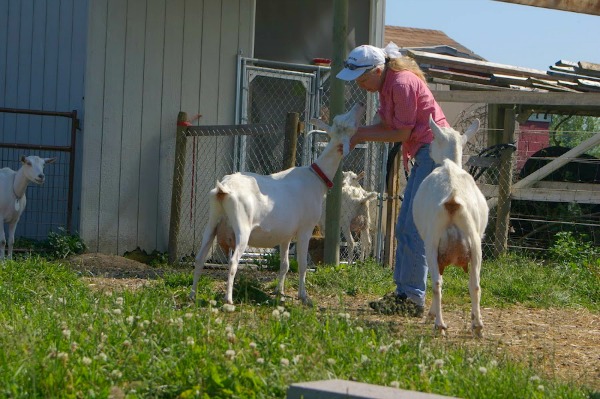
WESTERN WASHINGTON, SKAGIT VALLEY: We visited Garden Home Farm for an article in Hobby Farms and AcresUSA magazines. As you can see here, I found the dairy goats to be extremely friendly and happy. This mini dairy produced raw goat milk and eggs on a fraction of an acre utilizing an honor system set-up where people could come to the farm to get and pay for whatever they needed. She also sold at a nearby farmers' market. They had such a clever system for their chickens -- setting up a chicken coop made out of a tent -- that I wrote an additional blog just about that here.
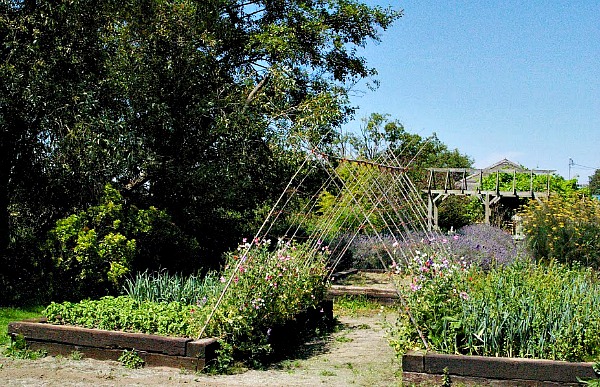
WESTERN WASHINGTON, SKAGIT VALLEY: Here's a well-made trellising system near Snow Goose Produce -- a seasonal farmers' market/country store along Fir Island Road in the valley.
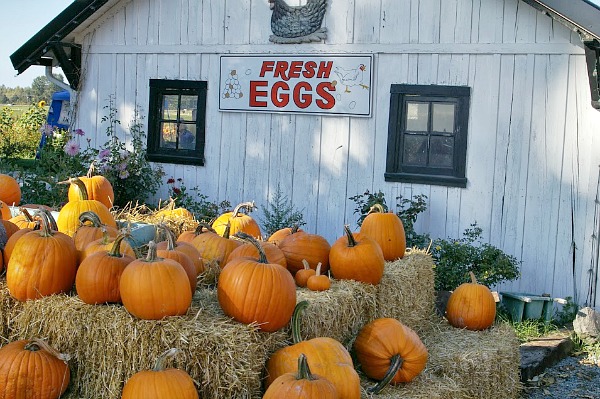
WESTERN WASHINGTON, SKAGIT VALLEY: Schuh Farms has a long time presence in the valley, and goes all out with agritourism, setting up attractive displays spring through fall. But most importantly, the displays are depicting what they or their nearby farming neighbors actually produce and sell on their farms as we see above; hay, pumpkins, eggs, etc. By contrast, cookie cutter "Old McDondald" farming stereotyped displays are a sell-out, in my humble opinion, if the display has nothing to do with what the farmer actually grows or services he or she actually provides (such as on-farm cooking classes). They do nothing to offer customers anything unique, nor to help non-farmers understand the variety and reality of a region's farms and ranches.
For example, setting up yellow straw bales everywhere so farm guests think they're on a real farm is somewhat stereotyped and regressive when it comes to regenerative farming. There's still a place for the use of straw even with regenerative, especially since it's essentially a byproduct of other crops and all byproducts need to be used. But it's thought of far differently now, in that monocrops that produce the straw may be quite degenerative. And, there are other more ecological options, such as elephant grass, for producing bedding for farm animals.
Still, if straw is part of a farmer or his or her farm neighbor's eco-enhancing produced crops, or if they source it from an organic operation and genuinely use it for straw bale raised garden beds for example, then certainly let it be part of their agritourism decor. They're one of the few who actually can authentically display it.
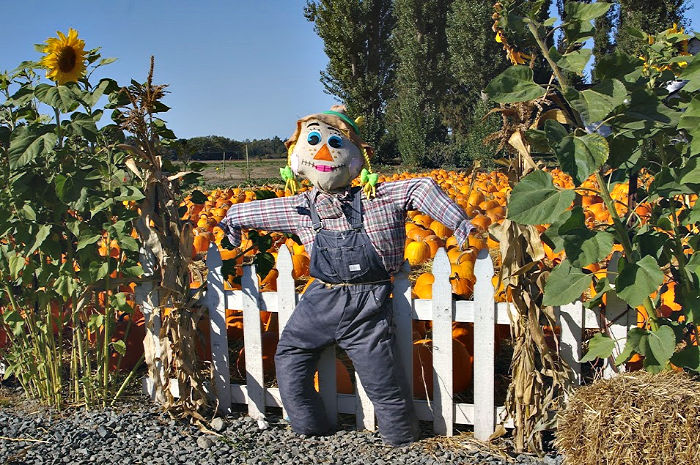
WESTERN WASHINGTON, SKAGIT VALLEY: But, when farms DO grow pumpkins, sunflowers, and so on, farms such as Schuh Farms in the photo above have great fun with it. They attract thousands of customers throughout the growing season.
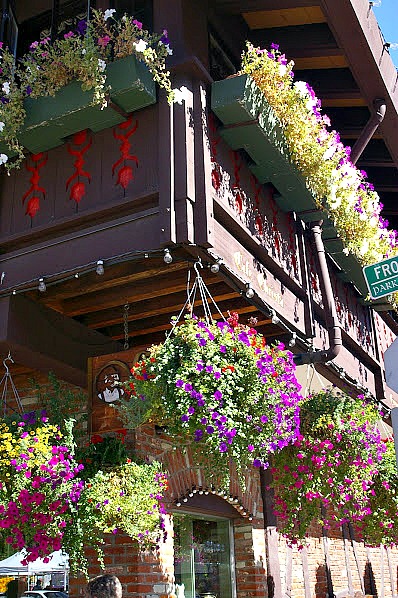
EASTERN WASHINGTON, CASCADE FOOTHILLS: The next couple of photos are from small eastern Washington towns that really take advantage of vertical growing space in the form of above ground containers. In the photo above from Leavenworth, which is in the middle area of eastern Washington, even the window box space is prolific. Here, it's mostly ornamental, but many edible (and beautiful!) crops grow well in containers, and can double as habitat as well, especially for pollinators.
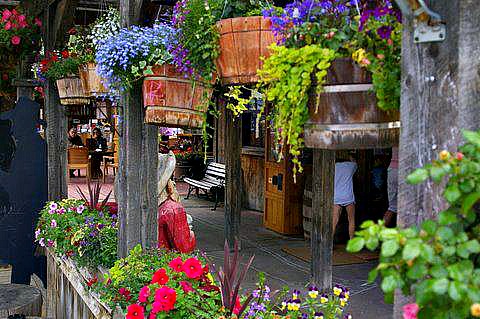
EASTERN WASHINGTON, CASCADE FOOTHILLS: These hanging containers and over-the-railing planters use rustic materials and include some edible plants such as the Johnny Jump Ups. This is in Winthrop, a small town in north eastern Washington.
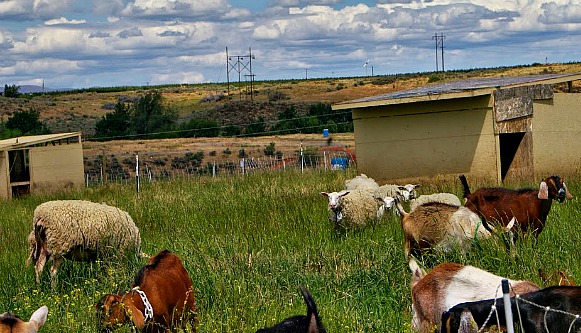
EASTERN WASHINGTON, YAKIMA COUNTY: Tieton Farm and Creamery, a small, humane, grassfed meat and dairy farm is in the southern half and very dry desert eastern bioregion of the state. I stayed overnight in the tiny town to get to know how this hamlet was restoring itself from what used to be a heyday of agriculture prosperity in the 40s and 50s, to eventual decline. A resulting profile of the farm was published for AcresUSA and a version is now here.

